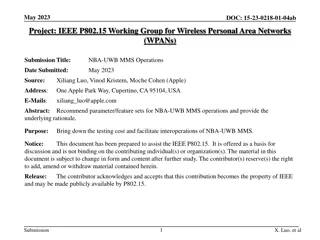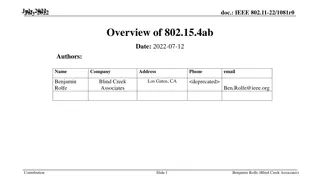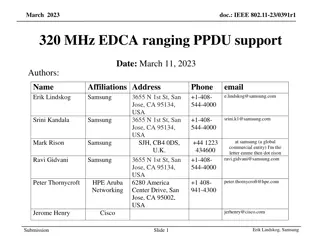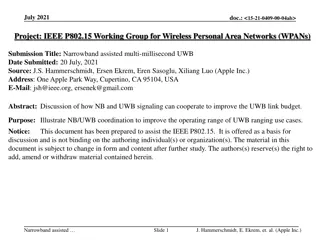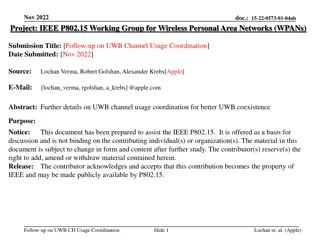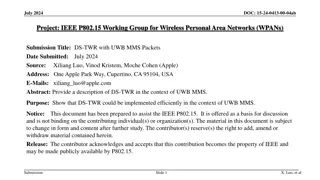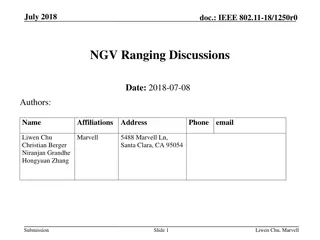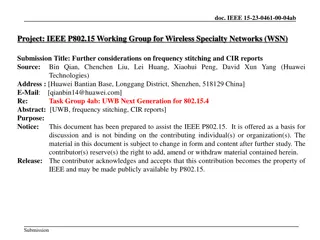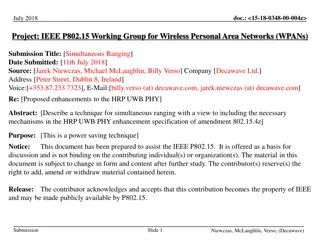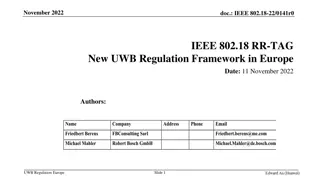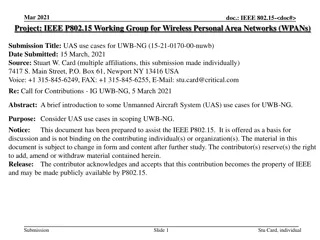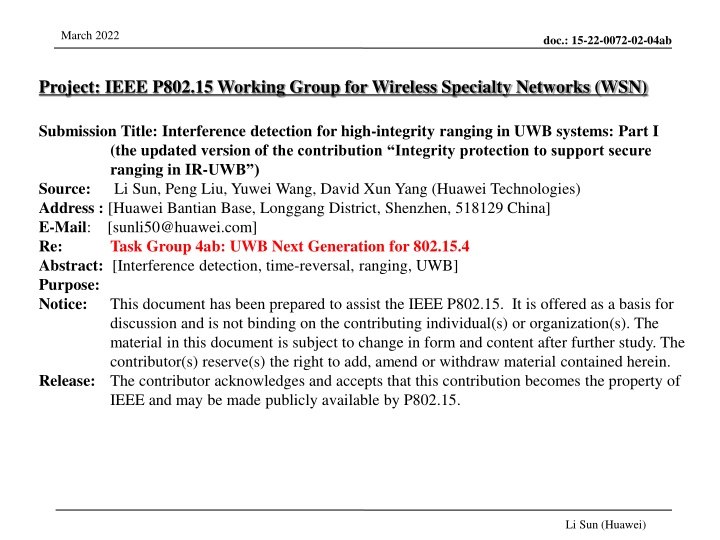
Interference Detection for High-Integrity Ranging in UWB Systems
Explore how interference detection enhances ranging performance in UWB systems, addressing coexistence challenges and improving accuracy and reliability. The proposal includes safeguards for different traffic use cases, interference mitigation techniques, and backward compatibility for enhanced ranging capable devices. The solution aims to reject ranging results when interference is detected, ultimately enhancing the efficiency and reliability of high-integrity ranging procedures.
Download Presentation

Please find below an Image/Link to download the presentation.
The content on the website is provided AS IS for your information and personal use only. It may not be sold, licensed, or shared on other websites without obtaining consent from the author. If you encounter any issues during the download, it is possible that the publisher has removed the file from their server.
You are allowed to download the files provided on this website for personal or commercial use, subject to the condition that they are used lawfully. All files are the property of their respective owners.
The content on the website is provided AS IS for your information and personal use only. It may not be sold, licensed, or shared on other websites without obtaining consent from the author.
E N D
Presentation Transcript
March 2022 doc.: 15-22-0072-02-04ab Project: IEEE P802.15 Working Group for Wireless Specialty Networks (WSN) Submission Title: Interference detection for high-integrity ranging in UWB systems: Part I (the updated version of the contribution Integrity protection to support secure ranging in IR-UWB ) Source: Li Sun, Peng Liu, Yuwei Wang, David Xun Yang (Huawei Technologies) Address : [Huawei Bantian Base, Longgang District, Shenzhen, 518129 China] E-Mail: [sunli50@huawei.com] Re: Task Group 4ab: UWB Next Generation for 802.15.4 Abstract: [Interference detection, time-reversal, ranging, UWB] Purpose: Notice: This document has been prepared to assist the IEEE P802.15. It is offered as a basis for discussion and is not binding on the contributing individual(s) or organization(s). The material in this document is subject to change in form and content after further study. The contributor(s) reserve(s) the right to add, amend or withdraw material contained herein. Release: The contributor acknowledges and accepts that this contribution becomes the property of IEEE and may be made publicly available by P802.15. Li Sun (Huawei)
March 2022 doc.: 15-22-0072-02-04ab PAR Objective Proposed Solution (how addressed) Safeguards so that the high throughput data use cases will not cause significant disruption to low duty-cycle ranging use cases Interference mitigation techniques to support higher density and higher traffic use cases Other coexistence improvement Backward compatibility with enhanced ranging capable devices (ERDEVs) Improved link budget and/or reduced air-time Additional channels and operating frequencies Improvements to accuracy / precision / reliability and interoperability for high-integrity ranging The proposed solution can be used to detect whether or not the ranging procedure is subject to external interference. If detected, the ranging results will be rejected. Thus, it provides an improvement to ranging performance. Reduced complexity and power consumption Hybrid operation with narrowband signaling to assist UWB Enhanced native discovery and connection setup mechanisms Sensing capabilities to support presence detection and environment mapping Low-power low-latency streaming Higher data-rate streaming allowing at least 50 Mbit/s of throughput Support for peer-to-peer, peer-to-multi-peer, and station-to- infrastructure protocols Infrastructure synchronization mechanisms Li Sun (Huawei) Slide 2
March 2022 doc.: 15-22-0072-02-04ab Related Contributions and Objectives Related Contributions Integrity protection to support secure ranging in IR-UWB <15-22- 0072-00-04ab>, Jan. 2022, Li Sun, et. al. Objectives of this contribution This presentation provides updates to the above contribution 15- 22-0072-00-04ab To clarify the background and motivations of the proposed techniques in the above contribution, and clearly describe the problem that the proposed technique wants to solve To provide more technical details, simulation results and performance comparisons to show the pros and cons of the proposed method in the above contribution Li Sun (Huawei) Slide 3
March 2022 doc.: 15-22-0072-02-04ab Background and Motivations High-accuracy ranging is of vital importance in applications such as keyless car entry, contactless payments, etc. Due to the openness of wireless medium, accidental or intentional interference from other transmitters may undermine the leading edge detection and cause performance degradation in ranging accuracy. Fake first path STS from the transmitter First path detection without interference Interference signal that may come from another UWB device First path detection with interference A mechanism is desired to detect potential interference and reduce its detrimental impact on ranging accuracy. Li Sun (Huawei) Slide 4
March 2022 doc.: 15-22-0072-02-04ab General Framework Initiator Responder Ranging frame 1 Ranging t1 (phase 1) t2 ToA estimate Time-reverse and Conjugate Generation of ranging frame 2 t3 Ranging (phase 2) t4 ToA estimate Integrity check Slide 5 Li Sun (Huawei)
March 2022 doc.: 15-22-0072-02-04ab Detailed Implementation (1) Step 1: Transmission of ranging frame 1 ? ? = ?? ? ?[? ?] Ranging frame 1 is a normal ranging frame consisting of preamble and STS STS Step 2: ToA estimate at the responder Using classical correlation-based approach and back-search algorithm The STS field of the received frame is extracted for further use Step 3: Generation of ranging frame 2 STS field of the received signal: ?2? = ? ? 12[?] + ?2[?] Time reverse and conjugate [ ?] = ? [ ?] 12 [ ?] + ?2 [ ?] ?[?] = ?2 1bit DAC (sampling rate: 499.2 MHz) Truncate the generated signal to make it of equal length as STS (optional) Li Sun (Huawei) Slide 6
March 2022 doc.: 15-22-0072-02-04ab Detailed Implementation (2) Step 4: ToA estimate at the initiator Time focusing effect ?1[?] = ?[?] 21[?] + ?1[?] [ ?] 21? +?1[?] = ? ? 12 ? 21? + ?2 channel reciprocity [ ?] 21? +?1[?] = ? ? 21 ? 21? + ?2 ?? : equivalent CIR Correlate ?1[?] with the time-reversed version of the local STS ? ? and find the peak Step 5: Integrity check Binaryzation: Output a binary sequence Y[k] based on the polarity of the real part of each sample of ?1[?] Correlation: Correlate Y[k] with the reverse version of local STS X[-k] ? Used to characterize the possibility of (not) being interfered ] z = ? ? ?[? ?=1 Comparison: Compare z with a threshold to determine whether an interference exists Li Sun (Huawei) Slide 7
March 2022 doc.: 15-22-0072-02-04ab Discussions Interference Detection Capability The interference occurs within ranging phase 1 After time-reversal and ranging frame 2 transmission, the interference signal will also appear in ?1[?], which causes the correlator in Step 5 to output low values. In some cases, the interference signal also causes the time advancement in ToA estimate in step 2. If this happens, the extracted signal field in this step will not be the entire STS, and some tail samples will be lost. The loss of samples results in a mismatch between the received signal and the template, which further decreases the integrity check score. The interference occurs within ranging phase 2 The received signal at the initiator will be ?1? = ? ? 21? + s?? ?1[?] + ?1[?] The interference signal exists in ?1? , thereby resulting in a failure in the integrity check. Li Sun (Huawei) Slide 8
March 2022 doc.: 15-22-0072-02-04ab Discussions Security Concerns The proposed ranging protocol seems to be vulnerable to relay attack, where an attacker sitting in the middle records the received signal and performs the same operation as the responder does. A reduction in the estimated round-trip time will be caused if this attack succeeds. However, the aforementioned relay attack can be well addressed by using the intrinsic redundancy structure of STS sequence. According to 15.4z standard, multiple 128-bit random sequences generated using DRBG are used to form a STS segment, in which a single 128-bit random sequence constitutes a so-called mini-segment . The proposed algorithm can be performed on the first several mini-segments only. In this way, only these mini-segments in ranging frame 2 will be a time-reversed version of the received signal, and the remaining mini-segments are generated using new 128-bit random sequences by the responder. The relay attack can be easily identified at the initiator after ranging phase 2: If the received signal is from an attacker, only the time-reversed mini-segments exist. Li Sun (Huawei) Slide 9
March 2022 doc.: 15-22-0072-02-04ab Simulation Parameters 16- s STS packet with configuration three (SP3) STS parameters: Delta length: 4, Segment length: 16 in units of 512 chips, Number of segments: 1 8th order Butterworth pulse SYNC Preamble Code 1 (length 31) Sampling frequency 499.2MHz 802.15.4a UWB channel model (Residential LOS/NLOS mode), 1000 channel realizations No frequency offset Benchmark schemes (see more details on the next page): A) Without explicit interference detection mechanism; B) Explicit interference detection is realized at the receiver side Li Sun (Huawei) Slide 10
March 2022 doc.: 15-22-0072-02-04ab Benchmark Schemes Benchmark A: The receiver correlates the received signal with the local STS template to build up the CIR, and performs the back-search algorithm to identify the first path, from which the ToA estimate is obtained. Benchmark B: The receiver first estimates the CIR based on STS cross-correlation, from which the earliest path can be identified. After that, the receiver decodes the STS based on the earliest path only. Finally, the decoded STS is compared with the expected template to determine whether or not an interference exists. Note: Benchmark B adopted here is inspired by the contribution 15-19-0134-00-004z Security vs. sequence length considerations , Mar. 2019 Li Sun (Huawei) Slide 11
March 2022 Comparison with Benchmark A Interference success rate An interference is considered to be successful if this interference is not detected (i.e., the integrity check passes) and the measured round-trip time is advanced by 6ns or more, corresponding to a distance reduction of 1.8m. doc.: 15-22-0072-02-04ab The interference success rate can be reduced from above 20% to less than 1%, fully demonstrating the capability of interference detection of the proposed method. LoS Scenario NLoS Scenario Li Sun (Huawei) Slide 12
March 2022 doc.: 15-22-0072-02-04ab Comparison with Benchmark A False alarm rate False alarm rate is defined as the probability that the initiator identifies an interference (i.e., the integrity check fails) but in fact no interference exists. The false alarm rate is negligibly small, which demonstrates that the proposed integrity check method is not sensitive to low- resolution quantization, inter- pulse-interference, noise, etc. Similar false alarm rate performance can be observed as compared to the LoS scenario LoS Scenario NLoS Scenario Li Sun (Huawei) Slide 13
March 2022 Comparison with Benchmark A Ranging accuracy doc.: 15-22-0072-02-04ab Ranging accuracy is characterized by the cumulative distribution function (CDF) of the absolute value of the round-trip-time measurement error. LoS Scenario, phase 1 interference LoS Scenario, phase 2 interference LoS Scenario, no interference NLoS Scenario, phase 1 interference NLoS Scenario, phase 2 interference NLoS Scenario, no interference Li Sun (Huawei) Slide 14
March 2022 doc.: 15-22-0072-02-04ab Comparison with Benchmark B Interference success rate Benchmark B (receiver-only method) proposed method LoS Scenario NLoS Scenario The proposed scheme is more advantageous than the receiver-only scheme in terms of interference success rate, although the performance gain is not very significant. Li Sun (Huawei) Slide 15
March 2022 doc.: 15-22-0072-02-04ab Comparison with Benchmark B False alarm rate A slightly increased false alarm rate is incurred by the proposed method for the low SNR regime. LoS Scenario NLoS Scenario Li Sun (Huawei) Slide 16
March 2022 doc.: 15-22-0072-02-04ab Comparison with Benchmark B Ranging accuracy LoS Scenario, no interference LoS Scenario, phase 1 interference LoS Scenario, phase 2 interference NLoS Scenario, phase 1 interference NLoS Scenario, phase 2 interference NLoS Scenario, no interference Li Sun (Huawei) Slide 17
March 2022 Summary of Simulation Results doc.: 15-22-0072-02-04ab Interference detection and suppression is helpful for ranging performance improvement Compared to Benchmark B, the proposed method, which follows a joint transmitter-receiver design philosophy, has a slightly enhanced ability in suppressing interference, achieves a comparable ranging accuracy, but yields a slightly increased false alarm rate From the implementation perspective, the advantages of the proposed method include the following: Low complexity: time-reversal at TX and binaryzation-correlation- comparison at RX, no decoding operation is needed Integrity verification is done only once for the entire ranging round, which further reduces processing overhead Li Sun (Huawei) Slide 18
March 2022 doc.: 15-22-0072-02-04ab STS+: A Processed Version of STS Source: IEEE 802.15.4z-20200 Source: IEEE 802.15.4z-20200 STS STS+ STS+ is generated using the proposed approach Truncation (optional) [ ?] = ? [ ?] 12 [ ?] + ?2 [ ?] 1bit DAC ?[?] = ?2 ?2? Note: STS+ is not a new ranging sequence, it is simply the processed version of the received STS at the responder New STS packet configurations should be provided in addition to the existing ones in 15.4z standard Li Sun (Huawei) Slide 19
March 2022 doc.: 15-22-0072-02-04ab Two Formats for STS+ [ ?] = ? [ ?] 12 [ ?] + ?2 [ ?] ?[?] = ?2 Format 1: Plain Format STS+ STS ? ??? + ? ??? 1 ? ??? Format 2: Truncated Format ? ??? STS STS+ ? ??? ? ??? ? ??? + ? ??? 1 Li Sun (Huawei) Slide 20
March 2022 doc.: 15-22-0072-02-04ab Negotiation Procedure A negotiation procedure needs to be added between the initiator and the responder to make an agreement on whether or not to support ranging with interference detection/suppression capability. Initiator Responder Negotiation The information to be exchanged includes but is not limited to: ranging frame configuration (normal frame or time-reversed frame) STS configuration STS+ format the number of STS/STS+ segments in each ranging frame PRF configuration for STS+ Ranging (phase 1) Ranging (phase 2) Li Sun (Huawei) Slide 21
March 2022 doc.: 15-22-0072-02-04ab Summary It is desired to incorporate interference detection/suppression mechanism in the next generation UWB standard to further improve ranging accuracy and robustness in complicated wireless environments A general framework is proposed to enable interference detection/suppression, under which a time-reversal based method is developed Simulation results are provided to show the pros and cons of the proposed method A new STS format is defined, and a negotiation procedure is also suggested in the ranging protocol Li Sun (Huawei) Slide 22

